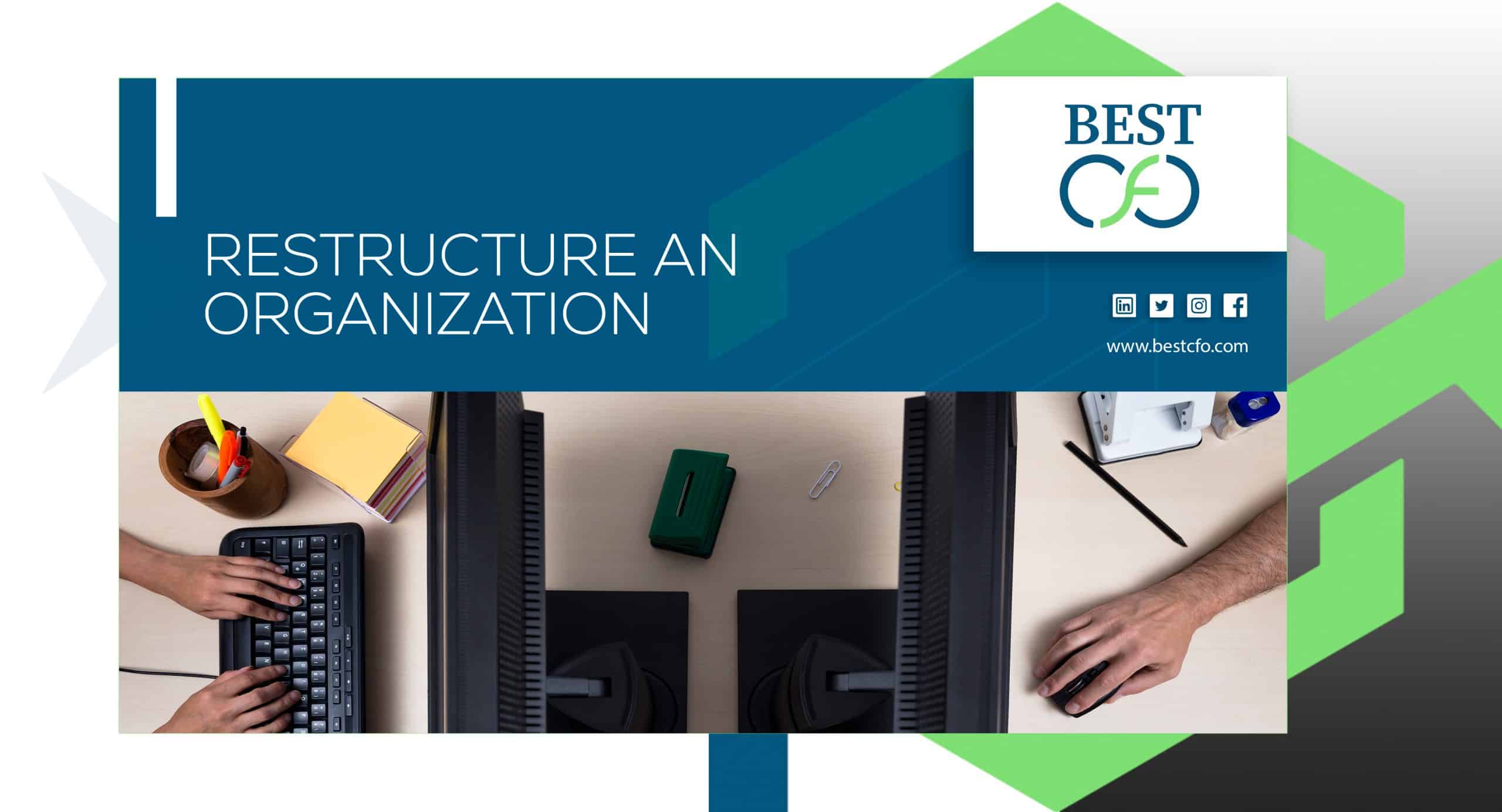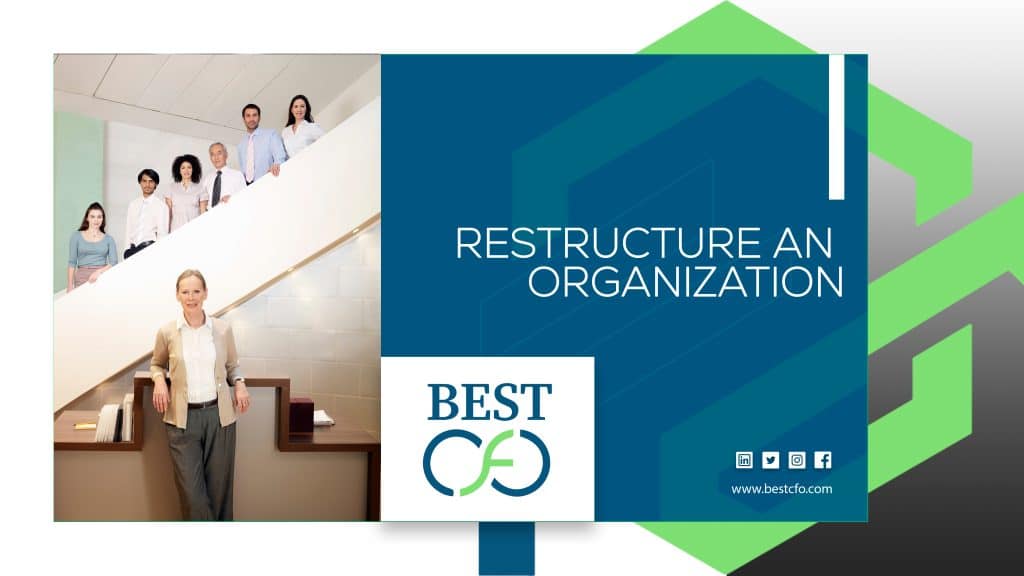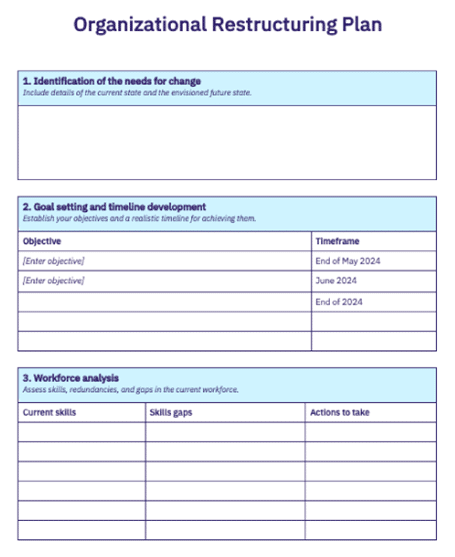
| Getting your Trinity Audio player ready... |
How To Restructure An Organization? Complete Guide 2025
Every growing company hits a point where things feel kinda… off.
Teams are bloated. Processes are clunky. Decision-making slows to a crawl. You’re spending more time managing people than moving forward.
Whether you’re facing a market shift, preparing for a merger, or simply outgrowing your current structure, this guide is your blueprint to doing it the smart way—with real examples, practical frameworks, and zero corporate BS.
What Is Company Restructuring?
Company restructuring is the redesign your business needs, so you can get aligned with new realities, challenges, and new goals.
That can mean shifting reporting lines, changing team functions, flattening leadership, spinning off units, or even redefining the entire operating model.
At its core, restructuring is about building a version of your company that actually fits your current (and future) strategy—not the one you had three years ago.
And no—it doesn’t always mean layoffs. Smart restructuring can be growth-oriented, culture-focused, or simply efficiency-driven.
Why Do Companies Restructure?
You don’t flip your org chart just for fun. It’s usually a response to real pressure—or serious opportunity. Here are the top triggers:
- Growth spurts: You’re scaling, but structure hasn’t kept up.
- Market shifts: Think digital transformation, new regulations, or industry-wide disruption.
- M&A activity: Integrating new people, products, and systems.
- Profit squeeze: Time to do more with less (or just smarter).
- New leadership: New CEO, new direction, new need to get things aligned.
- Strategic pivots: When your business model evolves, your structure better follow.
What’s HR’s Role in All of This?
If restructuring is surgery, HR is the operating team. It’s not just about moving boxes on an org chart—it’s about real humans navigating major change.
Here’s where HR steps in:
- Talent planning: Who’s in the right seat? Who needs to move, upskill, or transition?
- Change management: Crafting the message and guiding teams through it.
- Compliance and legal: No surprises, no lawsuits. Keep the process clean.
- Culture stabilization: Structure impacts identity—HR ensures you don’t lose your DNA.
Types of Organizational Restructuring (And When to Use Each)
Let’s cut through the noise. There are several restructuring styles—and each fits a different problem.
1. Legal Restructuring
- What it is: Changing ownership structure, entity type, or internal legal frameworks.
- Why use it: Tax efficiency, liability protection, investor requirements.
- Example: Reclassifying as an S-Corp or spinning off a subsidiary.
2. Functional Restructuring
- What it is: Redefining teams by function—marketing, ops, finance, etc.
- Why use it: Break silos, improve collaboration, streamline decision-making.
- Watch for: Over-centralization that slows down responsiveness.
3. Strategic Restructuring
- What it is: Aligning structure with long-term goals and market realities.
- Why use it: Your business is shifting—structure has to catch up.
- Example: A DTC brand adding a B2B division.
4. Cost Restructuring
- What it is: Cutting expenses without killing performance.
- Why use it: Margin pressure, recession prep, or capital efficiency.
- Checklist:
- Audit redundancies
- Consolidate roles
- Invest in automation where it counts
5. Divestment
- What it is: Selling or offloading parts of the business that don’t fit.
- Why use it: Focus, raise cash, reduce complexity.
- Example: A software firm selling off its hardware unit.
6. Mergers & Acquisitions (M&A)
- What it is: Integrating with or acquiring another company.
- Why use it: Expansion, market access, or IP acquisition.
- Caution: Culture clashes are real—don’t underestimate the people side.
7. Portfolio Restructuring
- What it is: Reevaluating where the company is placing bets (products, divisions, markets).
- Why use it: Strategic clarity. Kill underperformers, double down on winners.
- Tool: Use the GE-McKinsey Matrix to assess units by market attractiveness and business strength.
8. Cultural Restructuring
- What it is: Reinventing the internal vibe—how people work, lead, and collaborate.
- Why use it: Toxicity, complacency, or after major leadership shifts.
- Outcome: Hardest to pull off. Most impactful if done right.
How to Restructure an Organization (Step-by-Step)
Here’s the playbook. Not just theory—this is how real companies actually do it without burning everything down.
1. Start With Strategy, Not Structure
Structure follows strategy. If your org design isn’t helping you get where you’re going, you’re setting up landmines.
Ask:
- Where are we headed in 12–24 months?
- What’s stopping us from getting there?
2. Audit Your Current Org Honestly
What’s working? What’s broken? Where are people duplicating effort, hitting bottlenecks, or getting demotivated?
Tools that help:
- Org health surveys
- Workflow analysis
- 1-on-1 leadership interviews
3. Design the New Structure With Intent
Use org design principles like:
- Span of control: Too narrow = bloated leadership. Too wide = overloaded managers.
- Accountability clarity: Who owns what?
- Cross-functional agility: Build for collaboration, not chaos.
Sketch it. Stress test it. Then repeat it.

4. Communicate Like a Pro
People don’t fear change—they fear ambiguity.
The #1 killer of good restructures is poor communication.
Your plan:
- Over-communicate early
- Use multiple channels (email, all-hands, team leads)
- Be transparent about why it’s happening and what it means
5. Launch and Adjust
Roll out the new structure, but don’t pretend it’s perfect. Schedule check-ins at 30, 60, and 90 days. Collect feedback.
Start Planning Your Restructure Now
Don’t wait for a crisis. If your structure is showing signs of stress—fix it before it breaks.
And when in doubt? Bring in a financial strategist or outsourced CFO who’s done this before. You don’t have to wing it.
Tap into restructuring expertise and financial strategy resources at BestCFO.
Build a Cohesive Organizational Restructuring Plan
Restructuring isn’t just moving people around and hoping it works. It’s about aligning your team, your processes, and your goals so the business doesn’t just adapt — it evolves.
A strong restructuring plan keeps chaos in check. It sets a direction, creates confidence across teams, and gives leadership a way to track the impact.
Let’s break this down into something real.
Step 1: Define the Core Problem
Don’t restructure just because you saw another company do it. Figure out what’s broken — or about to break.
- Are teams overlapping or stepping on each other’s toes?
- Are your costs bloated compared to your actual output?
- Has the market shifted faster than your structure could keep up?
Once you define the problem, you’re no longer guessing — you’re solving.
Step 2: Reconnect with the Business Strategy
Now go back to your business strategy. What are you trying to achieve in the next 1 to 3 years?
- Is it growth? If yes, where — new products, new markets, better talent?
- Is it survival? Then you need to look at efficiency, agility, and maybe some tough decisions.
- Is it scale? That means process clarity, fewer silos, and cleaner lines of communication.
Your restructuring plan should exist to serve that strategy — not the other way around.
Step 3: Map Out the Current Structure
You can’t rebuild something without knowing what’s already there. Map out:
- Departments and teams
- Who reports to whom
- Existing workflows and how decisions get made
- Gaps, overlaps, or inefficiencies
This gives you a blueprint of what’s currently working — and what’s clearly not.
Step 4: Design the Future Structure
Now start sketching the new structure:
- What roles or departments need to be added, merged, or removed?
- Where should reporting lines shift to reduce bottlenecks?
- What capabilities are missing that you’ll need in 6–12 months?
Be bold, but realistic. You don’t need to change everything — you need to fix what matters.
Step 5: Anticipate Human Impact
People aren’t chess pieces. You’re not just changing processes — you’re affecting people’s roles, relationships, and routines.
Think about:
- Who might feel uncertain, left out, or undervalued?
- Where will you need to retrain, reassign, or even reduce staff?
- How will you support those going through change?
This is where HR becomes your co-pilot, not just your paper pusher.
Communicate and Support Transparency
The worst thing you can do during a restructure? Go quiet.
If people don’t hear the truth from leadership, they’ll write their own stories — and most of them will be wrong.
Here’s what transparent communication during restructuring looks like:
- Early messaging. Don’t wait until changes are made to talk about them.
- Frequent check-ins. Keep everyone updated — even if there’s nothing new to report.
- Two-way feedback. Give people a space to ask questions, share concerns, or offer suggestions.
- Visible leadership. This isn’t a time to hide in your office or just send emails.
Transparency builds trust, and trust is the only way people stay motivated during major change.
Organizational Restructuring Plan Template
Here’s a simple but powerful template to help you organize your plan. Feel free to adapt it for your company size and complexity.

1. Executive Summary
- Purpose of restructuring
- Business goals tied to this change
- Timeframe for execution
2. Current State Analysis
- Organizational chart and reporting lines
- Financial performance (costs, productivity)
- Key challenges and gaps identified
3. Future State Vision
- New structure (chart or written model)
- Strategic focus areas (growth, cost-efficiency, agility)
- Talent needs and capability shifts
4. Restructuring Approach
- Steps to be taken (phased or full-scale)
- Timeline with milestones
- Key leaders responsible
5. HR and People Impact
- Roles affected (redundancies, changes, reassignments)
- Training or upskilling needs
- Legal or compliance risks
6. Communication Plan
- Internal messaging schedule
- Channels used (town halls, emails, one-on-ones)
- Feedback collection methods
7. Risk Management
- Major risks (cultural, operational, reputational)
- Mitigation strategies
8. Metrics for Success
- How progress will be measured
- KPIs to monitor after implementation
9. Adjustment Mechanism
- How and when the plan will be reviewed
- Who owns accountability for iteration
The Bottom Line
Restructuring isn’t easy. But it’s often the difference between a company that adapts—and one that drowns in its own legacy systems.
So if your team feels misaligned, your org chart reads like a maze, or your goals outgrew your structure—take the hint. It’s time to rethink, realign, and rebuild.
That’s how to restructure an organization—like a grown-up.
FAQs: Organizational Restructuring
Does restructuring always mean layoffs?
No. It can—but restructuring can also mean hiring, realigning, or promoting.Who should lead a restructuring initiative?
CEO and CFO, with HR and department heads involved early.How long does a company restructure take?
Anywhere from 3 to 12 months, depending on complexity.What tools can help with org restructuring?
Org chart software (e.g., Lucidchart), employee surveys, workflow analytics.When is the right time to restructure?
When strategy shifts, growth stalls, or complexity is killing clarity.What’s the biggest mistake companies make during restructuring?
Under-communicating. Silence breeds fear and resistance.How do you measure restructuring success?
Faster decision-making, clearer accountability, improved morale, better performance metrics.Can small businesses restructure too?
Absolutely. In fact, it’s often easier—they’re more agile.How do you deal with resistance during a restructure?
Transparency, empathy, and involving people in the process.Should I bring in outside help?
If you’re unsure—yes. Experienced consultants or outsourced CFOs can save you time and costly mistakes, and you can find them on BestCFO.
Related Posts
What Are The 7 Qualities That Make A Good Team Player?
What Are The Best Ways to Improve Business Performance Ever felt like your business is…
Food and Beverage Consultant: Guide Every Restaurant Needs
Tangible vs Intangible Assets: What’s The Difference? Let’s be real: asset talk doesn’t exactly scream…
How To Deal With Angry Customers: 15 Tips & Tricks
Everything You Need t o Know About Variable Compensation In today’s fast-moving world of business,…
Why do Companies Choose to Outsource Work?
Everything You Need t o Know About Variable Compensation In today’s fast-moving world of business,…
 Demos
Demos  Colors
Colors  Docs
Docs  Support
Support 














